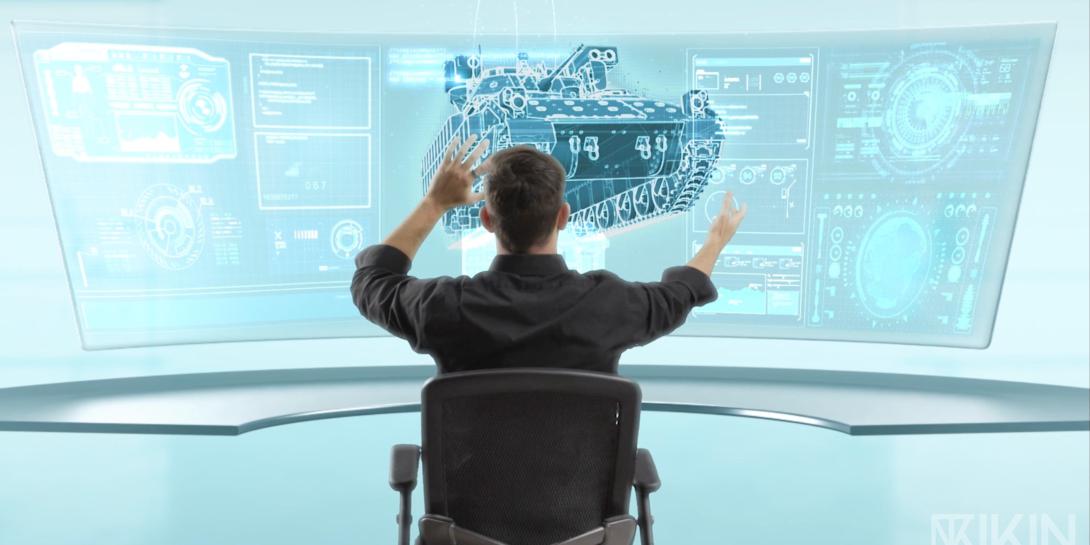Holograms Take Center Stage
Holograms paired with advanced communications networks are assisting the Navy, Marine Corps and special forces with logistics and operational efforts. Certain organizations in the services are relying on large-format holographic projection capabilities that display volumetric images. In desktop applications, the capabilities allow groups of people to collaborate around complex, visual data, and smaller, more mobile groups or single users at the tactical edge to see information quickly on handheld, portable devices. Most 3D-ready content can be applied to the solutions, such as augmented reality and virtual reality formats, and used for simulated and in-situ training exercises with gesture and touch screen interaction capabilities. The solutions from IKIN Inc., called IKIN ARC, and its partners enable users to harness legacy mobile, 4G and 5G networks.
In addition, the 3-D holographic technologies work in ambient light, eliminating the need for special goggles or headgear.
“Because we can create a holographic image in ambient light without any headgear, obviously, there's some advantages to that in a military setting where you don't want to be closed off from your surroundings,” explained IKIN CEO Joe Ward in an interview with SIGNAL Media. “Having the ability to take advantage of that and not be compromised in any way by having a limited field of view is important.”
One of IKIN’s business partners, Front Line Advisory Group—a company started by several retired special operations soldiers—is working to apply IKIN’s hologram and other technologies to special operations communities at Ft. Bragg, North Carolina, and other commands. IKIN has also developed an open software development toolkit integrated with Unity Technologies and other development platforms and has partnered with Federated Wireless and Vectrus Corp. to marry holographic technologies with advanced communications.
Front Line finds it is better to not come in with defined use cases, as the soldiers can see clear ways to apply holographic technologies to operations, said Chad Lawson, Front Line’s chief operating officer. So far, they have seen how the hologram solutions can aid those tactical forces’ planning and other combat processes.
“Typically, we would have to build out, either through 3D printing or a to-scale model of certain places or certain objectives we would like to approach, which is very time consuming,” Lawson clarified. “Or you can use augmented reality or virtual reality but that would require the use of googles. That is where the situational awareness [problem] comes in. Once you place goggles on inside an operations center it's not that big of a consideration, although no one really likes to do it or is not comfortable with it. But if you're trying to do quick planning in the field on a very short timeline, the use of augmented reality or virtual reality goggles completely takes you out of what is going on the ground and completely disables your situational awareness. You almost become a liability to force on the ground.”
It allows the forces to plan more quickly and efficiently, Ward said, as the capabilities offer users the ability to manipulate details within the digital images in the hologram through virtual touch control. “One of the biggest differentiators for us is providing that ‘Z’ access, that depth,” he said. To create an image, the platform pulls in various data sources—photographs, maps, videos, etc.—and leverages artificial intelligence to create the detailed holographic displays.
“Whether it's a vehicle or looking at what is behind a building or moving things around within that digital environment and being able to very quickly change it and to do planning, it's pretty effective,” Ward stated.
For the Navy and Marine Corps, IKIN and Vectrus are preparing advanced warehouse and logistics solutions. Under an other transactional authority with a Marine Corps facility in Albany, Georgia, Federated Wireless invited the companies to participate part of a secure 5G mobile technology deployment. In another application, the Navy is leveraging the solutions for a logistics modernization effort in San Diego.
“We're very much excited about 5G,” Ward stated. “The logistics, warehousing solution is using our technology to not only locate inventory, going through rows, aisles and getting to the inventory piece, and then being able to see inside the box and show that in a hologram. That's all using millimeter-wave on a 5G network. The implications of 5G, it really accelerates the utilization and what we can do with artificial intelligence and data flow.”
The companies are leveraging 5G communications, artificial intelligence and holographic applications to improve warehouse and facility operations. A 5G component, antenna, modem and compute power are all built into a small card for the holographic solutions. “The user has the ability to set this up as a CAC [common access card] card, a credit card, a debit card, and this is about as state of the art as can be, as we build out this 5G logistics environment,” said Mike Wells, chief innovation officer, Vectrus.
For the Navy effort, the holographic technologies provide detailed 3D imaging, which are perfect for logistics, he continued.
“The whole genesis of that effort is, ‘How do you build a next-generation logistics facility over 5G?’” shared Wells. “You can actually walk around the facility and see the components in 3D with the hologram without ever having to actually physically open the inventory. The notion of ‘what might a next-generation logistics modernization look like?’ is where you have that capability to actually view every aspect of an item without ever having to pull it out of the box.’”





Comments